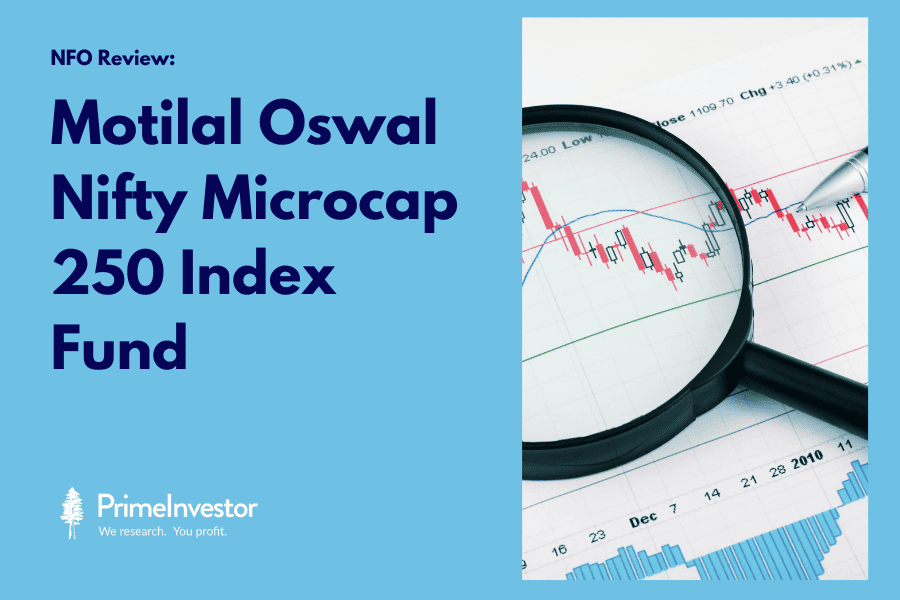Of the passive options that have caught investor attention, the NFO of the Motilal Oswal Nifty Microcap 250 index is the newest. This fund aims to mimic the Nifty Microcap 250 index – this index comprises the 250 stocks beyond the Nifty 500. Given that the Nifty 500 itself covers 95% of the total market capitalisation, the Microcap 250 will most definitely hold the tiny stocks.

The allure of microcaps comes mainly from the potential for multi-bagger or very high returns during bull market phases, much more than either the midcap segment or smallcaps. To give an example, between the 2020 low and the 2022 high, the Microcap 250 index level rocketed from about 2410 to 11626 – that’s nearly a 5x gain. That is higher than the approximately 3x and 3.5x gain of the Nifty Midcap 150 and the Nifty Smallcap 250. Obviously, returns don’t come without risk, and the Microcap 250 is much more volatile and falls steeper than the mid-and-smallcaps.
On the face of it, therefore, the Motilal Oswal Nifty Microcap 250 may seem like a good portfolio addition for those with the appetite for high risk and a long timeframe.
But we have our reservations.
At this time, our view is that the index fund will not make a suitable addition to most portfolios, even if you have the risk appetite for it. Four reasons why:
- The Nifty Microcap 250 lacks real-time history to know how sector make up changes based on market cycles and if performance sustains. Back-worked data is not always reliable.
- The Microcap 250 has not seen any clear correction unlike the smallcap segment. To this extent, the index has already rallied sharply and investing now would be at much higher levels.
- Active small-cap funds also dip into the microcap pool and to this extent, pick the quality ones already. Returns of smallcap funds compare well with the Microcap index.
- Tracking error of the index fund is unknown. Microcaps have even more liquidity issues than smallcaps. While the AMC is confident of managing this, the tracking error of the existing Nifty 500 and Midcap 150 funds are already on the higher side.
Let’s get into more detail on the index and the reasons above.
The Nifty Microcap 250 index
The Nifty Microcap 250 was launched in May 2021 but has a base date April 2005 (i.e., index data from April 2005 to May 2021 has been back-worked using the index methodology). The Microcap 250 represents the stocks outside the Nifty 500 index. This index is constructed as follows:
- The eligible universe of stocks for index is the top 1000 stocks by average full market capitalisation and based on traded volumes. Separate conditions on impact costs and extent of free-float market cap apply.
- From this universe, those in the Nifty 500 and other possible larger stocks by market cap (which are not part of the Nifty 500 for whatever reason) are removed. From this shortlist, the top 250 in terms of full market cap make up the index.
- The stocks in the index are weighted based on free-float market cap. The index is rebalanced every six months.
The average market cap of the stocks in the index is about Rs 3652 crore, but the lowest market cap is just about Rs 1,000 crore. To compare, the lowest marketcap of the Nifty Smallcap 250 is Rs 2,621 crore but the average is at about Rs 10,383 crore.
The microcap segment is always an enticing segment as it will have stocks that can serve up extremely high returns as the stock is discovered or grows. But it’s also a difficult and tricky ask for individual investors assess the universe and pick those gems. Information is hard to come by and the space is replete with fundamentally unsound stocks.
In this context, taking the fund route is a better way to participate in the microcap segment. In terms of overall returns, the Microcap 250 compares well with the Nifty Smallcap 250. The table below shows how the two indices fare on performance and risk. This is based on rolling return data over the past 10 years (using the back-worked data where applicable; the Smallcap 250 has real-time data from 2016).
As the data shows, obviously, the Microcap 250 is more volatile than the Smallcap 250, falls harder and more frequently. This is made up by the superlative gains during rallies. On a 5-year basis, the Microcap 250 beats the Smallcap 250 91% of the time.
Recent performance
But in recent times, the Microcap 250 behaved slightly differently. The smallcap segment corrected in 2022, while the large-cap Nifty 50 remained rangebound. The Smallcap 250 hit its post-2020 high in January 2022 and is still not reached those levels. The rally in this segment has taken off only recently, as we pointed out in our recent smallcap fund recommendation.
The chart below shows the movement of the Smallcap 250 index against the Microcap 250.
In contrast, the Microcap 250 has not corrected as much. It hit a high in December 2022, similar to both the midcap and largecap segments. It again chalked a new all-time high in June as did the midcaps. This performance can be explained by its stock and sector make up.
- One, the index has high weight to sectors that markets currently love. The top sector weight is capital goods at 19.5%. This sector has taken market fancy by storm across the board as prospects looked up after years of slump. Another big sector is auto ancillaries. The smallcap index has lower weights in these rallying sectors but higher weights in financials, IT, and consumption, which have been more volatile.
- Two, several stocks have seen very sharp rallies. Nearly 4 in every 10 stocks have returned over 50% in the Microcap index, many from the segments above. For example, stocks such as Titagarh Rail, Power Mech Projects, Kirloskar Oil, Garden Reach Shipbuilders, Tega Industries, Usha Martin, Ramkrishna Forgings all doubled, tripled or quadrupled. (P.S. some of these names also find place in our Auto++ smallcase and Prime Stocks!)
The table below shows some of the top returning stocks in the index.
The 43% 1-year returns of the Microcap index reflects this superlative performance. But it is this aspect that also gives us cause for concern:
- There is no historical data for the index as it was launched only in 2021. Therefore, we do not know how sector composition or stock universe changes with markets. This is important as sectors such as capital goods, auto, construction, metals – all of which have contributed to the current rally – are extremely cyclical. If they remain part of the index in the event of a correction, they can weigh on returns for a long while.
- The rally in many of these stocks has been swift and high, sending valuations well above normal. While the market overall is positioned to climb towards new highs and expectations of further rallies is strong, how much further the Microcap index would rally is not clear – the NFO comes at the right time in the sense that returns are strong, but the timing also makes it necessary to be quick in booking profits at the right time.
- The Smallcap 250, since it has shown at least some correction, offers more scope to participate in a rally.
All this aside, we also do not want to rely entirely on the Microcap index’s back-worked data as these are usually theoretical levels. As we have seen in many other indices, real-time index performance has differed widely from the back-worked performance. So without actual index levels to judge performance from, we do not want to draw conclusions over future potential.
Smallcap funds participation
The Microcap 250 is not the only source for microcap participation. Small-cap active funds, as well as other active funds, fish in this pool! The table below shows the MF holding in some of the top performers of the Microcap index – as you can see, in many cases, the holding is high. Therefore, you may not be fully missing the stock opportunity in tiny caps.
More, active smallcap funds have also shown consistency in beating the Microcap index. Take the 5-year rolling return over the past 10 years. On this count, many smallcap funds – including those recommended in Prime Funds – have beaten the Microcap 250 all the time.
In 3-year rolling periods too, the outperformance consistency across the category is strong. Even discounting the back-worked data, this ability of small-cap funds to beat the Microcap 250 is a key positive. This is important in our view:
- One, active small-cap funds fulfil the return criteria that you might look for.
- Two, they offer access to the microcap space and the funds would tend to pick only stocks with stronger fundamentals. To this extent, it could be better than holding the entire microcap universe and can help lower the risk.
- Three, given that there is limited understanding of how the Microcap index would perform in the long term, profit booking would be necessary if you invest in it. It may not suit long-term portfolios. A small-cap fund would help address this issue; funds also are better at containing downsides.
Motilal Oswal Nifty Microcap 250 - Tracking error
The final aspect is, of course, how well the Motilal Oswal Nifty Microcap 250 would be able to mimic the index returns. Even though the index places criteria on impact cost, most stocks in the microcap index lack liquidity. Going by the tracking error of index funds based on the Nifty 500, Nifty Midcap 150 and Smallcap 250, it will be a challenge.
Therefore, the tracking error of the Motilal Oswal Nifty Microcap 250 needs to be assessed, which will take time. It depends on what the eventual AUM will be, how it sees and deploys inflows and whether it will gate fresh inflows to manage liquidity and error. If the latter happens, it becomes an impediment to consistent investing.
To summarize, we don’t see the need to add the Motilal Oswal Nifty Microcap 250 to your portfolio at this juncture. Holding quality small-cap funds will be sufficient in tapping the high return potential in small stocks. We will assess the index’s performance as well as the fund and will change our recommendation if we see the need. If you are keen to add the Motilal Oswal Nifty Microcap 250 anyway as it is an interesting opportunity, track performance closely and be ready to book profits if the index starts to correct.
The Motilal Oswal Nifty Microcap 250 NFO is already open and will close on June 29.






9 thoughts on “NFO Review: Motilal Oswal Nifty Microcap 250 Index Fund”
I have a question about the reliability of back-worked data.
If the index is well defined and accurate data are available for the stocks, why should it be unreliable?
What am I missing? Do you mean something more than the numbers when you say it’s unreliable?
Look at returns based on live data means an index is already there and you cannot change the index to suit returns. But by back working data, there is always a possibility that the index was built based on that set of stocks that would give great back-worked returns. Hence the portfolio (and its logic) is tweaked to generate desired historical results. Once an index is live, such tweaking is not possible :-). Hope this helps. Vidya
Not a very good article. You are trying to mix two things here: 1) Should you invest “now” in the NFO 2) Should you consider this index at all for investment. You are trying to address both these Qs but the argument/analysis isn’t really convincing. Moreover, the recommendation is driven largely by technical/short-term view rather than a long-term view.
Appreciate your view. We have addressed the former and made note of the index performance (which we should as it is an passive fund). Given that the stocks in the index is not picked with any fundamental metric, we obviously have to also consider the momentum in the space, given the nature of stocks that appear in the filter 🙂 That does not make this a technical view. In an NFO, the question of whether to invest now is the foremost and for that timing is a call (not necessarily technical). thanks, Vidya
Very helpful to not fall into the temptation 🙂
Hi
Any plans to review the other hot NFO on the block – the SAMCO active momentum fund ?
Thanks
No sir. There is no way to analyse it unless we see what it does with its strategy. The passive momentum funds have had their ups and downs. This one is active and will use derivatives too. So need to only observe. It’s strategy stated is too general to make any meaningful opinion 🙂 Vidya
Thank you.
🙂 Thanks, sir! Regards, Bhavana
Comments are closed.